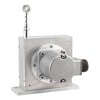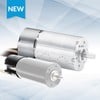Help with Incremental Rotary Encoders specifications:
Electrical Output and Interface
Back to Top
|
|
| ||
| Electrical Output and Interface | The type of electrical signal that will be produced. | ||
| Your choices are... | |||
| Digital: Square Wave | Digital output signal lines for direct interfacing with a processor or co-processor (typical for most encoders). Most typical is a square wave or two square waves that can be resolved via quadrature to four counts per line. | ||
| Analog Voltage | The output is an analog voltage such as 0-10V or ±5V. | ||
| Analog Current | The output is an analog current such as a 4-20 mA or 0-20 mA current loop. | ||
| Serial | The output conforms to a standard serial format such as RS232, RS422, RS485, etc. | ||
| Parallel | The output conforms to a standard parallel format such as general-purpose interface bus (GPIB). | ||
| SSI | Serial synchronous interface (SSI) is a general standard for absolute encoders. The physical interface consists of two differential connections aside from power and ground. The controller provides a clock input, and the sensor returns a data signal synchronized to the clock. | ||
| Ethernet | Ethernet is a local area network (LAN) protocol that uses a bus or star typology and supports data transfer rates of 10 Mbps. The Ethernet specification is the basis for the IEEE 802.3 standard, which specifies the physical and lower software layers. To handle simultaneous demands, Ethernet uses carrier sense multiple access / collision detection (CSMA/CD) to monitor network traffic. | ||
| FOUNDATION Fieldbus | The FOUNDATION fieldbus is a serial, all-digital, two-way communication system that serves as a local area network (LAN) for factory instrumentation and control devices. It uses a line or tree topology and distributed data transfer (DDT). In the hierarchy of digital networks, the FOUNDATION fieldbus is on the lower end. | ||
| CANbus | Controller area network bus (CANbus) is a high-speed serial data network designed for harsh electrical environments and real-time control applications. It operates at data rates up to 1 Mbps and provides excellent error detection and confinement capabilities. | ||
| INTERBUS® | INTERBUS® is a fieldbus network based on the cyclic, serial transmission of input/output data between a master and slave stations. Common versions include INTERBUS-S®, INTERBUS-R®, and INTERBUS-MUX® (MUX). INTERBUS, INTERBUS-S and INTERBUS-MUX are registered trademarks of Phoenix Contact GmbH & Co. | ||
| DeviceNet | DeviceNet uses controller area network (CAN) network protocol to connect industrial devices such as limit switches, photoelectric cells, valve manifolds, motor starters, drives, and operator displays to programmable logic controllers (PLCs) and personal computers (PCs). | ||
| PROFIBUS® | The process fieldbus (PROFIBUS®) is a popular, open communication standard used in factory automation, process automation, motion control, and safety applications. PROFIBUS is standardized in IEC 71158 and IEC 61784 and is suitable for both fast, time-critical applications and complex communication tasks. PROFIBUS is a registered trademark of PROFIBUS International. | ||
| SUCOnet | SUCOnet Class 1 and 2 (K1 and K2) are 16-bit serial communication interfaces developed by Moeller GmbH for use with programmable controllers and automation products. | ||
| Other | Other unlisted, specialized, or proprietary encoder outputs. | ||
| Search Logic: | All products with ANY of the selected attributes will be returned as matches. Leaving all boxes unchecked will not limit the search criteria for this question; products with all attribute options will be returned as matches. | ||
Encoder Technology
Back to Top
|
|
| ||
| Encoder Technology | |||
| Your choices are... | |||
| Optical | Incremental angular counting is achieved by a light emitter and receiver; outputs can be sine-cosine waves or digitized square waves. Configurations include transmissive systems in which light passes through a transparent disk or is blocked by an opaque line, and reflective systems in which lines are segments of nonreflective space on a strip between reflective segments. | ||
| Mechanical | Counting is achieved by the disk engaging periodic spring-loaded detents or other mechanical switches. | ||
| Fiber Optic | Fiber optic signal transmission is often combined with optical sensing. The transmission of position signals by light is advantageous in applications where high noise or EMI/RFI levels could interfere with electrically transmitted signals. | ||
| Magnetic | Position measurement results from a sequence of magnetic switches being activated, or by the resolution of interaction between magnetic fields. | ||
| Search Logic: | All products with ANY of the selected attributes will be returned as matches. Leaving all boxes unchecked will not limit the search criteria for this question; products with all attribute options will be returned as matches. | ||
| Modular Kit | Modular kit encoders have minimal or frame-like support, but do not include a complete housing. They provide flexibility and are relatively easy to assemble. | ||
| Search Logic: | "Required" and "Must Not Have" criteria limit returned matches as specified. Products with optional attributes will be returned for either choice. | ||
| Ring / Bearingless | Ring or bearingless encoders are non-contact rotary encoders involving two parts: the encoder body and a separate shaft/disk. They are nearly maintenance-free. | ||
| Search Logic: | "Required" and "Must Not Have" criteria limit returned matches as specified. Products with optional attributes will be returned for either choice. | ||
Performance Specifications
Back to Top
|
|
| ||
| Resolution (counts per revolution) | The number of counts per revolution, including any interpolation, quadrature, or other electronic count multiplication. | ||
| Search Logic: | User may specify either, both, or neither of the "At Least" and "No More Than" values. Products returned as matches will meet all specified criteria. | ||
| Resolution (lines per revolution) | The number of cycles per revolution of the raw square or sine wave output. This is the same as the number of lines or tick marks on the encoder disk (or equivalent). | ||
| Search Logic: | User may specify either, both, or neither of the "At Least" and "No More Than" values. Products returned as matches will meet all specified criteria. | ||
| Count Rate | Count rate is the maximum rate of count generation. | ||
| Search Logic: | All matching products will have a value greater than or equal to the specified value. | ||
| Positional Accuracy | Positional accuracy is the maximum error of a reading, in arc seconds. One degree is 3600 arc seconds. | ||
| Search Logic: | All matching products will have a value less than or equal to the specified value. | ||
Mechanical Specifications
Back to Top
|
|
| ||
| Diameter or Width | The body diameter of a circular encoder, or the maximum side dimension of a square body encoder. | ||
| Search Logic: | User may specify either, both, or neither of the "At Least" and "No More Than" values. Products returned as matches will meet all specified criteria. | ||
| Maximum Mechanical Shaft Speed | The mechanical shaft speed is the maximum speed at which the device can rotate without sustaining physical damage. | ||
| Search Logic: | All matching products will have a value greater than or equal to the specified value. | ||
| Rotor Inertia | Rotor inertia of the encoder shaft system. | ||
| Search Logic: | All matching products will have a value less than or equal to the specified value. | ||
Encoder Signal Output
Back to Top
|
|
| ||
| Your choices are... | |||
| Quadrature | Quadrature refers to A and B channels that are 90° out of phase. The sine and cosine signals may be read and combined. The theoretically infinite resolution is limited only by the resolution of an external digitizing device. | ||
| Single Channel | Single channel devices are unidirectional or "tachometer" encoders. The single channel allows for one count per physical line. | ||
| Pulse & Direction | With pulse and direction, a direction channel may be combined with single-channel counting or multiple-channel counting with quadrature. | ||
| Search Logic: | All products with ANY of the selected attributes will be returned as matches. Leaving all boxes unchecked will not limit the search criteria for this question; products with all attribute options will be returned as matches. | ||
| Reference / Index Channel? | An index signal is a once per revolution output used to mark a reference position. The index signal may also be referred to as a marker, home, or Z position. | ||
| Search Logic: | "Required" and "Must Not Have" criteria limit returned matches as specified. Products with optional attributes will be returned for either choice. | ||
Features
Back to Top
|
|
| ||
| Hollow Shaft | The encoder accepts and attaches to a shaft from another component. | ||
| Search Logic: | "Required" and "Must Not Have" criteria limit returned matches as specified. Products with optional attributes will be returned for either choice. | ||
| Programmable | Programmable or field-configurable indicates that the operator can program or set some operating parameters such as resolution, output coding, and offsets. | ||
| Search Logic: | "Required" and "Must Not Have" criteria limit returned matches as specified. Products with optional attributes will be returned for either choice. | ||
| Intrinsically Safe | Intrinsically safe (IS) is an adjective for equipment and wiring which is incapable of releasing sufficient electrical or thermal energy under normal or abnormal conditions to cause ignition of a specific hazardous atmospheric mixture in its most flammable concentration. The IS terminations and wiring may be brought into any hazardous location of any group classification for which it is accepted without requiring explosion-proof housing or other means of protection. | ||
| Search Logic: | "Required" and "Must Not Have" criteria limit returned matches as specified. Products with optional attributes will be returned for either choice. | ||
Environment
Back to Top
|
|
| ||
| Operating Temperature | This is the full required range of ambient operating temperature. | ||
| Search Logic: | User may specify either, both, or neither of the limits in a "From - To" range; when both are specified, matching products will cover entire range. Products returned as matches will meet all specified criteria. | ||
| Vibration Rating | This is the maximum sustained vibration that the encoder can withstand and still meet performance specifications. | ||
| Search Logic: | All matching products will have a value greater than or equal to the specified value. | ||
| Shock Rating | This is the maximum shock acceleration that the encoder can withstand and still meet performance specifications. | ||
| Search Logic: | All matching products will have a value greater than or equal to the specified value. | ||


